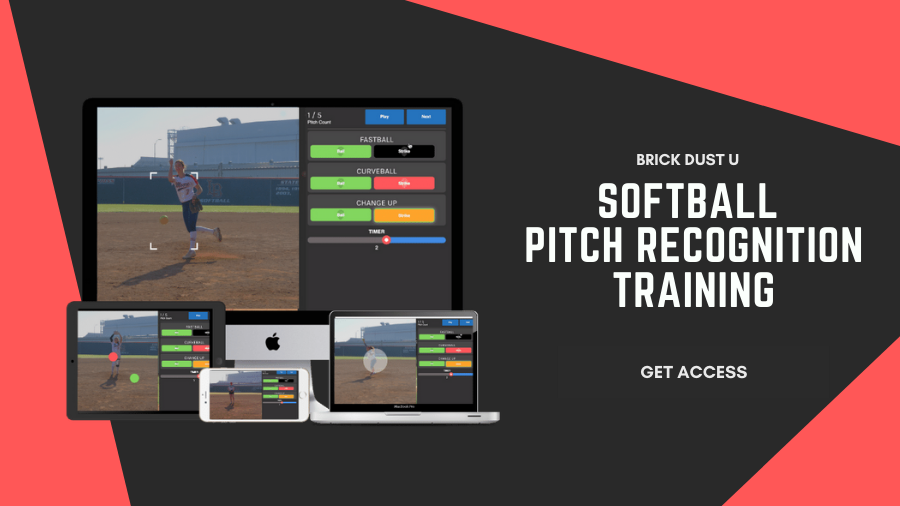
When it comes to softball pitch recognition: tips, tricks & drills at Brick Dust University, we're motivated by one important truth.
Learning to recognize pitch-types is one of the most important aspects of having quality at-bats at the plate.
It’s also essential to be an elite-level hitter. But what exactly is pitch recognition and how can you improve it? In this guide, we’ll break down pitch recognition, explain the cues to look for in a pitcher’s windup, and give you some drills to practice.
What Exactly Is Soft Pitch Recognition?
Pitch recognition refers to the batter’s ability to pick up movements made by the pitcher.
This ability helps the batter determine if the incoming pitch is a ball or strike, as well as what kind of pitch it is. Pitch recognition involves watching the pitcher’s windup at three key points - before the release, right at the release, and immediately after release.
With pitch recognition, the goal is to judge accurately which pitches will be in the strike zone, which will veer out of the strike zone, and which will just barely touch the edge of the strike zone.
How Do You Train for Better Pitch Recognition?
Sports scientists who’ve studied athletes’ reflexes have found that those with a better response time don’t have naturally faster reflexes.
These athletes have simply trained more, or been exposed to the ballistic movements they must react to over and over.
Experts have concluded, therefore, that the best way to improve pitch recognition is with recognition training.
Recognition training is exactly what it sounds like – you train yourself to recognize pitches by watching different types of pitches.
You study pitchers’ movements and watch for the spin of the ball.
You can do this with live pitching or by viewing videos of a pitcher from the batter’s perspective, pausing just after it’s released, and guessing what the pitch will be.
This method of softball pitch recognition training has been studied extensively by developers of the Applied Vision Baseball pitch recognition training app.
Cues to Look for in the Pitcher’s Windup
Which signs should you watch for in the pitcher’s windup when you’re training for pitch recognition?
Look for three things:
- The step
- The release
- The spin.
The Step
The first thing to watch is where the pitcher steps with her lead foot during her windup. If she steps across her body, away from her throwing arm, then it’s a curveball.
Secondly, if she steps wide, in the same direction as her throwing arm, then it’s a screwball.
Lastly, if she’s not noticeably stepping in one direction or another, then it’s either going to be a changeup, rise ball, or drop ball.
The Release
If you can’t tell what the pitch is by watching the step, then watch the pitcher’s arm for the release.
For a changeup, the release can be done in a number of ways. Two of the most common are with her hand over the ball at release or holding it sideways, like a soda can.
For a rise ball, the pitcher will dip her shoulder and release it with her hand underneath the ball.
Finally, for a drop ball, she’ll roll her shoulder forward and spin the ball downward for the release, like she’s turning a doorknob.
The Spin
The final cue to watch for is the spin. Noticing the spin on the ball isn’t something you’ll pick up right away.
It takes a lot of practice, watching different types of pitches over and over so your brain is accustomed to seeing the spin and associating it with a certain pitch.
Check out some of the drills and tips below for how to train yourself to notice spin, as well as improving pitch recognition overall.
Tips and Drills for Pitch Recognition in Softball
As we mentioned, pitch recognition will only improve with practice. There are several drills you can use to train yourself at picking up the pitch before it enters the strike zone (or veers away from it at the last second).
The Yes/No Drill
In this drill, you take up your stance at the plate and have a coach or another player throw you batting practice. But you won’t be swinging the bat at all.
Instead, watch each pitch as it comes in and before it hits the catcher’s glove, call out “ball†or “strike.†You can also say “yes†for a pitch you’d swing at or “no†for a pitch you wouldn’t.
What will help you decide if a pitch is a ball or strike before it gets to you?
You should look for your cues – where the pitcher steps, release point, and spin.
The point of this drill is training your brain to recognize the signs of each pitch, so you should do it repetitively to let it sink in.
The Cone Drill
The cone drill simply expands upon the Yes/No Drill. Do the same as the Yes/No Drill, but have a coach place a cone or glove at the spot in the pitch path where you called out ball and strike.
Your goal should be moving that cone closer to the pitcher with each pitch, indicating that you decide on the pitch sooner.
Readjust Your Eyes
Another way to practice good pitch recognition is by training your eyes to adjust to long and short distances. Before stepping into the batter’s box, hold up your bat in front of you and look at the barrel, focusing on the logo...
...then, shift your eyes toward something off in the distance, like the scoreboard or foul pole.
After, shift your eyes back to your bat’s barrel. Look at the distance object once more, then step into the box and take up your stance.
By forcing your eyes to focus and refocus on near and far objects, you’re preparing yourself for when the pitch is released.
You’ll have to focus on the ball when it’s far away to pick up the spin, then refocus as it approaches the plate. If you’ve just practiced this beforehand, your eyes will have an easier time adjusting.
Pick Up a Baseball Bat If you want to practice locating the spin on the ball, then try swinging in the batting cages with a wooden or heavy bat and a baseball.
A baseball spins and moves more quickly than a softball.
As a result, training with a baseball will make it easier to see the spin when you switch back to a softball.
For more great tips and drills on pitch recognition, check out this video from Extra Inning Softball.
Softball Pitch Recognition: Tips, Tricks & Drills
If you want to play at an elite level in softball, you have to master pitch recognition. It’s not enough to have solid mechanics.
A good place to start is with these Softball Pitch Recognition: Tips, Tricks & Drills.
Good form should be backed up by a keen sense of which pitches to swing at and which not to.
By putting in the work to improve pitch recognition, you’ll have more success as a hitter.
Train Your Pitch Recognition
Start your softball pitch recognition training at 40% off with an annual membership in Brick Dust University.

Follow Us
Facebook: https://www.facebook.com/brickdustu/
Instagram: instagram.com/brickdustuniversity/
Subscribe on Youtube: https://www.youtube.com/BrickDustU
